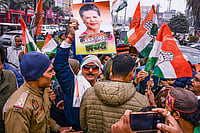- Fifteen months after the violence, Kandhamal district still tense
- Parting of ways between the BJD, BJP has added to the tension. Sangh parivar leaders say with the BJP out of the government, the Hindutva campaign will become proactive.
- Over 3,000 Christian riot victims still housed in relief camps
- Not a single accused named in the 783 riot cases registered in 2007-2008 has been convicted yet
***

A burnt church in Muniguda during the riots
The recent split between the BJP and BJD has only added to the uncertainty. The situation is such that a stray incident could reignite the violence—in time for the two-phased elections on April 16 and 23. "When in government, the party had some compulsions. Now the demands of the Hindus will be implemented. We want justice for all," says Mohanty. He was arrested for his alleged involvement in the '07-08 riots but is now out on bail.
The parting of ways between the BJP and BJD, say local Sangh leaders, has only liberated their Hindutva agenda. "With the BJP part of the government, our workers were hampered," admits Priyanath Sharma, VHP state joint secretary. "But the split has revived us and we'll ensure the BJD loses. All our workers will now campaign for the BJP and tell the people how the BJD plans to suppress Hindus by tying up with the Left parties and Christians," he adds.
Despite the talk, ground realities are different. In the December '08 municipal elections here, the BJP fared poorly, winning only three wards of the 12 it contested. Indications are that the BJP may fare poorly from here in the assembly elections in April too. Kandhamal returns three seats to the assembly. The district also forms part of the Phulbani Lok Sabha constituency, currently represented by Sugrib Singh of the BJD.
While Hindu leaders go into overdrive to "save their faith", Christian leaders are hoping only for justice and peace. Archbishop of Cuttack and Bhubaneshwar Raphael Cheenath says, "There is no normalcy in Kandhamal, only a semblance of it" (see interview). Even now there are over 3,000 Christians sheltered in state-run relief camps in the district. Most of those who have returned have either done so as Hindus or have housed themselves together in temporary clusters near their original homes. Some of the houses still retain scars from the violence and in some areas villagers are still afraid of reclaiming what once belonged to them for fear of renewed violence.
"I often see the people who attacked my village. They roam freely, even threaten us. We will not return to our homes till they are arrested by the government," says Juan Nayak, a local Christian living in a collective temporary shelter. The insecurity is amplified because the courts are yet to convict anyone in the 783 cases filed against the 2007-08 rioters.
But convictions will just be the beginning. The two communities have been at loggerheads for decades. While Christians argue that they are being persecuted, Hindus say the Dalit Pana Christians declare themselves Hindus in state surveys to corner land and affirmative action benefits meant for SCs and STs—something they aren't entitled to. (A household survey was cancelled recently after it emerged that the majority of the riot-affected Christians had earlier declared themselves as Hindus.) The state has now launched an inquiry.
Other unresolved problems include Laxmanananda's murder and illegal conversions. According to the Orissa Freedom of Religion Act, every conversion must be registered but only two conversions to Christianity have been recorded by the authorities since 1967. This does not tie up with the phenomenal growth Christianity has enjoyed in the state—the 2001 census says it went up by 35 per cent between 1991-'01, while the average population grew by only 16 per cent. All vexing issues. A solution to the communal divide seems nowhere in sight despite efforts by inter-faith groups and a newly unencumbered state.






















